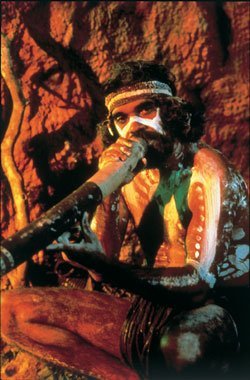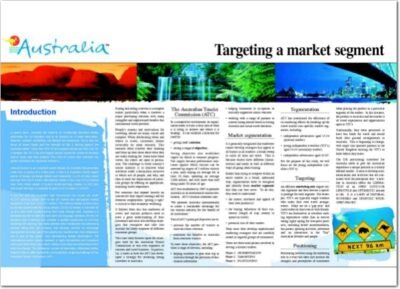
In recent years, Australia has become an increasingly desirable holiday destination for UK travellers due to its diversity as a travel destination, beaches, outback, rainforests, city lifestyle and adventure. This is also the result of cheap flights and the strength of the £ sterling against the Australian dollar; more than 50% of all European arrivals are from the UK. In addition, the UK is the third largest source market for visitors to Australia behind Japan and New Zealand. This influx of visitors from overseas has greatly benefited the Australian economy.
Inbound tourism is an important export industry for Australia that generates more than a quarter of a million jobs. In fact it is Australia’s fourth largest earner of foreign exchange dollars and represents 11.2% of total export earnings from the 5 million international visitors in the June 2001 financial year. Every billion dollars in tourism export earnings creates 11,367 jobs and export earnings is expected to grow to 30.8 billion in 2008-9.
In the last year, the Australian High Commission has issued just under 40,000 working holiday visas to the UK market (the backpacker market represents more than 100,000 visitors). The working holiday scheme aims to provide opportunities for young people (18-30) to holiday in Australia for up to a year while supplementing their funds through work. Australia is a desirable country to both live and work (no language problems for the UK traveller) and a working visa provides a perfect opportunity to combine travelling with working. Key trade partners have introduced visa processing services along with job contacts and advisory services to encourage backpackers to make use of the opportunity. Australia has many attractions and is one of the world’s best backpacking holiday destinations. The international tourist industry, however, is highly competitive and Europeans wishing to travel have many short, medium and long-haul destinations from which to choose. The increasing number of alternative, affordable holiday opportunities on offer represents a considerable, ongoing challenge for the Australian Tourist Commission (ATC).
For countries that depend heavily on tourism for their export earnings and for domestic employment, ‘getting it right’ is critical to their economic wellbeing. It follows from this that marketers of travel and tourism products need to have a good understanding of their customers and must also develop strategies that recognise and take into account the likely response of different consumer groups.
This case study focuses on the strategies used by the Australian Tourist Commission to win over segments of the tourism and travel business. In particular, it looks at how the ATC has developed a strategy for attracting young travellers to Australia.
The Australian Tourist Commission (ATC)
In a competitive environment, an organisation needs to have a clear idea of what it is trying to achieve and where it is heading. It can establish a direction for itself by:
- giving itself a mission
- setting a range of objectives.
Setting objectives also establishes targets by which to measure progress. The targets become performance indicators against which success can be assessed eg targets of 3 million visitors a year, each staying on average for at least 10 days, spending on average 1,000 dollars, and with more than half being under 30 years of age.
ATC was established in 1967 to promote Australia as an international tourism destination. ATC’s mission statement says: ‘We promote Australia internationally to create a sustainable advantage for our tourism industry, for the benefit of all Australians.’ Two of ATC’s principal objectives are to:
- increase the number of visitors to Australia from overseas
- maximise the benefits to Australia from overseas visitors.
To meet these objectives, the ATC provides a range of services, including:
- helping travellers to plan their trip to Australia through the provision of destination information
- helping businesses to cooperate in mutually supportive tourist ventures
- working with a range of partners to convert strong interest levels in visiting Australia into actual travel decisions.
Market segmentation

It is generally recognised that marketers cannot develop strategies that appeal to all buyers in all markets: a broad sweep to catch all does not work. This is because buyers have different characteristics and needs as well as different ways of going about buying. Rather than trying to compete within an entire market in a broad, unfocused way, organisations have to recognise and identify those market segments that they can best serve. To do this, they need to understand:
- the nature, attributes and appeal of their own product(s)
- the buying behaviour of their customers (length of stay, money to spend on travel)
- the potential size of their market.
They must then develop sophisticated marketing strategies that are carefully aimed at targeted groups of consumers. There are three main phases involved in serving a distinct market:
Phase 1: SEGMENTATION
Phase 2: TARGETING
Phase 3: POSITIONING
Segmentation
ATC has maximised the efficiency of its marketing efforts by breaking up the travel market into specific market segments, including:
- independent adventurers aged 25-34 (primary market)
- young independent travellers (YITs) aged 18-24 (secondary market)
- independent adventurers aged 45-65.
For the purpose of this study, we will focus on young independent travellers (YITs).
Targeting

An efficient marketing mix targets certain segments and then devises a specific package for each segment. For example, YITs are typically single students who make their own travel arrangements. Many are on a ‘gap year’ and travel either on their own or with friends. YIT sees themselves as travellers seeking experiences rather than as tourists seeing sights opting for low-price products, including hostel accommodation, bus passes, sporting activities, adventure and an immersion in the “fun” Australian lifestyle and people.
Positioning
Positioning involves using the marketing mix in a way that takes into account the thoughts and perceptions of consumers when placing the product in a particular segment of the market. In this instance, the product is Australia and the market is all travel experiences and opportunities open to YITs.
Traditionally, they were perceived to have fewer funds for travel and would book their ground arrangements in Australia. This is beginning to change, with major tour operator partners in the United Kingdom enticing the YITs to book before they leave.
The UK positioning statement for Australia seeks to give the Australian experience a unique position in a clearly defined market. It aims to develop communications and activities that are consistent with the perception that: ‘a holiday in Australia offers the LIBERATION of an OPEN OUTDOOR LIFESTYLE and OPTIMISTIC attitude to life. It is a LAND of NATURAL WONDERS and UNSPOILT WIDE-OPEN SPACES’.
Meeting the needs of younger travellers
The marketer’s job is to understand consumers’ attitudes towards products and to translate their positive support or interest into some form of action. When trying to convert consumers’ expressed interest in visiting Australia into actual visitation, the starting point is to understand the behaviour of targeted consumers. For example, European long-haul travellers view Australia as a good opportunity for individual experiences that the mass tourist destinations of the Mediterranean cannot provide.
European travellers also look for novel experiences in unfamiliar environments and amid different cultures. Australia’s appeal is strongly driven by people’s perceptions of the open and outdoor lifestyle, as well as by its natural beauty and space. Younger travellers look for a sense of adventure and are attracted to the more challenging and active elements such as snorkelling, surfing, white water rafting and bungee jumping. They will look to immerse themselves in the experiences and lifestyles of Australians and they are attracted as much by the potential experience as by the prospect of visiting the main tourist areas.

Australia is perceived as a safe destination for first time travellers but still has an adventure based element which is one of the primary motivators for this target market.
Marketing strategies
The ATC’s marketing strategy involves both trade marketing to organisations as well as consumer marketing directly to travellers.
For example, the ATC works closely with tour operators (eg STA, USIT, Trailfinders), with airlines (eg Qantas and Singapore Airlines) and with other organisations that are seeking to tap into the Australian market based in the UK. In developing these opportunities, the ATC produces a couple of key consumer publications that are the main tool for providing information to the consumer. These are the annual Travellers Guide and a consumer website, australia.com. The ATC also participates in trade events and provides regular newsletters for industry partners. Much of this communication is now done through web based activity via their corporate website www.atc.australia.com.
Brand Australia
The Brand Australia campaign has been launched across the major markets of Europe. Branding supports the positioning process. It uses a range of features that help consumers to identify and develop perceptions about a range of products which convey a series of attributes, benefits, values and promises.
The essence of the Brand Holiday Australia strategy was to identify the brand as being ‘naturally free-spirited’. The brand is conveyed as being:
- free-spirited
- colourful
- optimistic.
The values of the brand help to show what it stands for and what it believes in. Brand Holiday Australia promotes three virtuous images, conveying the idea that Australia and Australians are:
- genuine
- open
- unpretentious.
These positive images are then linked to tangible product benefits (eg safe adventure, the awe inspiring feeling of vast landscapes) as well as to a range of brand attributes, the ease of experiencing the landscapes and the open outdoor lifestyle.
Targeting younger travellers

A marketing communicator starts with a clear target audience in mind. Having targeted the youth market, it was important to develop a message that elicited an appropriate response. The aim of the communication process was to encourage young people not just to think about, it but to make a decision to go to Australia. With young travellers, the approach was to communicate the aspects of Australia that would most appeal to them:
- young, vibrant, dynamic – city life
- innovative – lifestyle, food and wine, culture
- active and sporty – beaches, trails, surf and sports facilities
- fun-loving – places to party, with festivals and events.
At the same time, it was important to help young people to think about what they do within Australia by highlighting:
- the easiest travel options to move around Australia
- the wide diversity within regions
- the uniqueness of many Australian experiences.
Working holiday visas
Australia’s working holiday maker scheme aims to promote international understanding by allowing young people to experience the culture of another country. It allows young working holidaymakers to have an extended holiday by supplementing their incomes through employment. Applications come from those between 18 and 30 without dependent children and show that the main reason for coming to Australia is for a cultural and social holiday that promotes mutual understanding between Australia and other nations and they intend to supplement their funds with temporary work.
Meeting the objectives
The richness of the Australian experience creates many opportunities for targeting younger travellers. The ATC also received a huge boost with the opportunities presented by images from the Sydney Olympics, the Paralympic Games in 2000 and the millennium celebrations. As a result, there has been a significant growth of Europeans arriving in Australia increasing its market share of international tourism: at the same time, total visitor expenditure by overseas visitors within Australia has increased and this has increased export earnings from tourism as well as the number of people working within the tourism industry.
Conclusion

ATC’s experience in recent years exemplifies the potential rewards that stem from a disciplined and focused approach to marketing. Know your product and its attributes. Identify your potential customers. Determine how best to engage their interest and commitment. It’s a familiar formula, and it works.
 Targeting a market segment (PDF)
Targeting a market segment (PDF) 